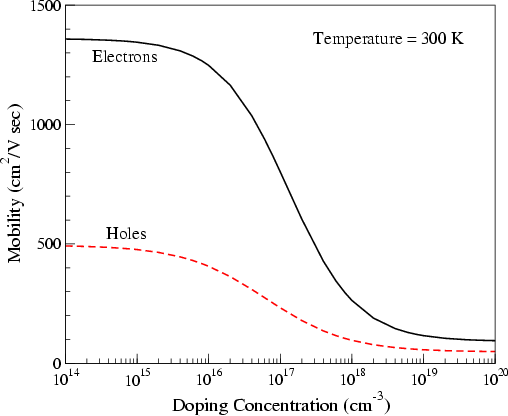
Previous: 3.1.1 Semiconductor Transport Physics Up: 3.1 Transport Physics Considered for Power Semiconductor Devices Next: 3.1.3 Carrier Recombination and Generation
The mobility is defined as the drift velocity ![]() per unit electric
field in a homogeneous semiconductor:
per unit electric
field in a homogeneous semiconductor:
 |
(3.13) |
The carrier mobilities ![]() and
and ![]() account for the scattering mechanisms
in electrical transport [18]. Dominant mechanisms are lattice scattering, impurity scattering,
and carrier-carrier scattering. All of these scatterings
reduce the carrier mobilities. A further mobility reduction is
due to the saturation of the drift velocity of warm and hot carriers
which is caused by lattice vibrations.
In general, these mechanisms are very complicated and difficult to model.
For the purpose of numerical device simulation, several empirical models have been
suggested by Caughey and Thomas [113], Lombardi [114], Masetti [115],
and Selberherr [18,22].
account for the scattering mechanisms
in electrical transport [18]. Dominant mechanisms are lattice scattering, impurity scattering,
and carrier-carrier scattering. All of these scatterings
reduce the carrier mobilities. A further mobility reduction is
due to the saturation of the drift velocity of warm and hot carriers
which is caused by lattice vibrations.
In general, these mechanisms are very complicated and difficult to model.
For the purpose of numerical device simulation, several empirical models have been
suggested by Caughey and Thomas [113], Lombardi [114], Masetti [115],
and Selberherr [18,22].
 |
Figure 3.1 shows the carrier mobilities in silicon as a function
of doping concentration from the measured data [116].
The electron mobility and hole mobility have a similar doping dependence.
At room temperature, ionized impurity scattering effects are small for
doping concentration below ![]()
![]() and the mobility is
almost constant and is primarily limited by phonon scattering.
At higher doping concentrations, the mobility of electrons
and holes decreases with increasing doping concentration due to
ionized impurity scattering.
and the mobility is
almost constant and is primarily limited by phonon scattering.
At higher doping concentrations, the mobility of electrons
and holes decreases with increasing doping concentration due to
ionized impurity scattering.
Jong-Mun Park 2004-10-28